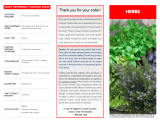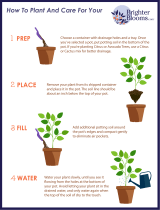Page is loading ...

SOIL PREPARATION
Full to part sun.
LIGHT/SUN
EXPOSURE
USDA HARDINESS
ZONES
PLANTING
DISTANCE
IN-GROUND
At least 3 feet apart.
Winter hardy in-ground in zones
7 to 11.
In zones 3 to 6, we recommend
planting in a container so you can
move the plant indoors before the
first frost.
MATURE
HEIGHT / SPREAD
August Beauty: 5 feet tall with a 3
foot spread.
Radicans: 12 inches tall with a 36
inch spread.
August Beauty: Spring to fall.
Radicans: Summer.
Fragrant blooms.
Attracts butterflies.
Heat tolerant and great for containers.
BLOOM TIME
FACTS OF NOTE
PLANT TYPE
Tropical.
CONTAINER SIZE
One plant per 16-inch or larger
container.
We recommend having your soil tested periodically by
your local County Extension Office (www.nifa.usda.gov/
extension or by calling 1-800-333-4636). A soil test can
determine if your soil needs any amendments to enhance
the growth and performance of your plants.
Ideal garden soil is easy to dig in and drains well while still
holding the nutrients and water vital to plant growth. To
prepare a bed for in-ground planting, spade or till the soil
to a depth of roughly 12-18 inches. Next, spread a 2-4 inch
layer of organic matter such as compost, shredded leaves
or peat moss over the soil and mix well.
QUICK REFERENCE PLANTING GUIDE
GARDENIA
Thank you for your order!
There's no fragrance more intoxicating than that
of a blooming Gardenia! With an abundance of
sweetly scented blooms, Gardenias perfume the
summer garden. Velvety, snow white petals stand
out against deep green foliage for a look that is
truly stunning. Gardenias are ideal for containers
and perfect for patios, decks, and balconies.
Caution: Do not assume any plant is safe to
eat. Only parts of plants expressly grown to
be eaten should be considered edible. As with
any product that is not food, care should be
taken to make sure that small children and
pets do not ingest any part of the plant that is
not expressly grown to be eaten.
Unless specifically stated, this product is intend-
ed for ornamental horticultural use only and is
not intended for consumption or ingestion by
humans or pets. Most plants are harmless, but
some contain toxic substances which can cause
adverse health effects. Furthermore, some indi-
viduals and some animals are sensitive or allergic
to certain plants and precautions should be taken
to limit or avoid physical contact with particular
plants. Some plants have thorns or spines that
can be painful if handled.
In case of ingestion contact a poison
control center immediately.
1-800-222-1222
*Image on cover is representative of the type of plant(s) in this offer
and not necessarily indicative of actual size or color for the included
variety.

PLANTING INSTRUCTIONS (Continued)
PLANTING INSTRUCTIONS
Adequate and consistent watering is essential during
your plant's first year in the garden. Infrequent, long
soakings of water that thoroughly saturate the soil
are more effective than frequent, light applications of
water.
Due to variable geographical and environmental
conditions, a specific watering schedule is difficult to
define. However, as a rule of thumb, you should not
allow the soil or the original root ball to completely
dry out. During the first summer, you may need to
water as often as every few days in periods of
drought and extreme summer heat. To determine if
your plant needs water, dig a few inches into the soil
next to the plant. If the soil is dry 2-3 inches below the
surface, it is time to water.
Overwatering can be as damaging as under watering.
Be sure that the area surrounding your plant has
adequate drainage to move water away from the
plant. If you choose to plant in a container, always
select one with drainage holes to prevent your
plant's roots from sitting in water.
FEEDING
Feed your plant once every 2-3 weeks during the
growing season with a water-soluble fertilizer for acid
loving plants. Discontinue fertilizing by September
1st so your plant can prepare for winter.
MULCHING
WEEDING
Apply a 2-4 inch layer of shredded bark, compost,
leaves, straw or other organic matter around your
plants to promote moisture retention, maintain even
soil temperatures and discourage weed growth.
Replenish the mulch as needed.
Keep the area around your plants free of weeds.
Weeds compete with surrounding plants for food,
water and light. Walk around the garden periodically
and pull weeds, including the roots, as soon as you
see them.
WINTERIZING
In mild zones (7-11), gardenias may be left in the
ground during winter. If freezing weather is expected,
protect the roots by mounding a 6-8 inch layer of
shredded bark, compost, leaves, straw or other
organic material around the base of the plant. Potted
gardenias should be moved into a protected area on
exceptionally cold nights.
In colder zones (3-6), gardenias should be grown in
containers and moved indoors before the first frost.
Select a room that is bright, preferably one with
southern exposure. Indoors, plants tend to dry out
from a lack of humidity. To boost the humidity level
around your plant, fill a shallow tray with gravel and
water, then place the pot in the tray. The water level
should be slightly below the gravel so that the pot
is not submerged in water. As the water evaporates,
it will create a more humid environment for your
plant.
Watering should be reduced significantly while the
plant is indoors. Do not overwater or allow your
plant to sit in water. Remove any unsightly or dead
growth as needed over the winter.
In spring when temperatures begin to rise, ease the
plant into a full watering schedule and move it back
outdoors for the summer.
CONTINUING CARE (Continued)
A
In zones 3-7, we strongly recommend planting your
gardenia in a container in order to properly protect it from
winter damage. Use the following instructions as a guide
for container planting.
Important: Thoroughly hydrate the plant by submersing
the root zone in a container of water for 10 minutes while
you prepare for planting.
B
Water well and, if necessary, adjust the plant so it is
upright and add additional soil if needed. Check to
be sure the plant is not planted too deeply. If it is,
raise the plant carefully and re-firm the soil.
C
Once the plant is properly positioned in the pot,
begin filling the pot with soil. Work the soil around
the root ball with your hands, firming the soil
around the plant with your fingers. When the hole is
filled, tamp the soil to remove any air pockets.
Fill the container with soil to within 4 inches of the
top. Remove the pot and prepare the root ball for
planting by gently disturbing the surface roots with
your fingers, fork, or gardening tool and pruning
any damaged roots. Dig a hole in the soil to insert
the lower part of the root ball.
Remove spent flowers as blooms fade, and prune any
dead or unsightly growth as needed to maintain an
attractive appearance. Branches that have become
overlapped or damaged can be removed at any time.
PRUNING
WATERING
CONTINUING CARE
OUT OF THE BOX
Your plants have been shipped to you in pots. We urge
you to remove them from the shipping box and plant
them as soon as possible. Should planting be delayed due
to weather or other unforeseen circumstances, roll the
plastic bag down around each plant and place them near
a bright window or other sunny location. Keep them
well-watered in their pots until permanently planted.
Once planted, they begin setting roots and, as the weath-
er warms, begin showing new growth. Please plant as
soon as possible, provide reasonable care and be patient.
The foliage on potted plants may appear slightly wilted or
yellow upon arrival. This is due to the stress of shipping
and is usually nothing to worry about. Water the plant
thoroughly, place it in a shady location and remove any
foliage that does not recover.
GARDENIA
SHIPPED AS SHOWN
/




